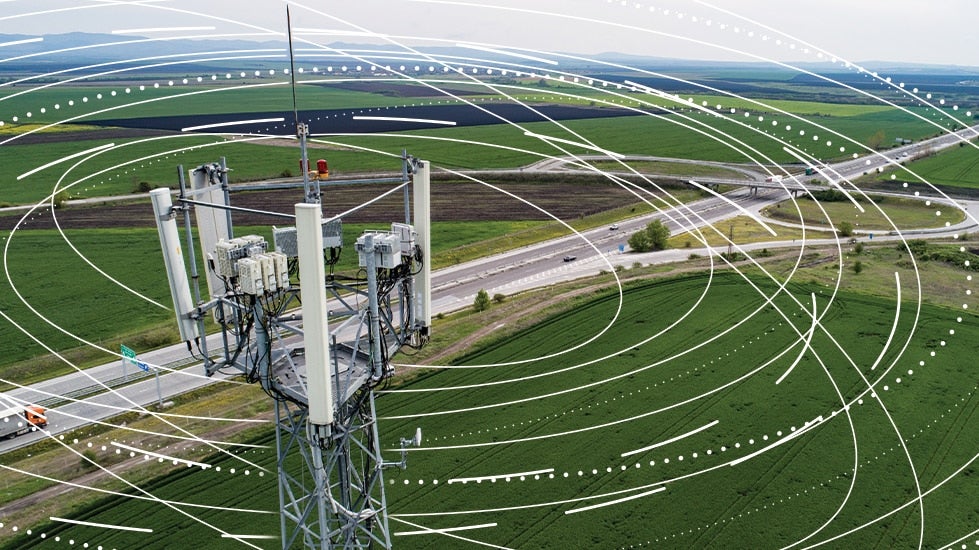
There’s no doubt about it. Advances in connectivity promise to reshape how we do business — and lead our lives. A revolution of smart solutions helps us manage our homes more efficiently, enjoy entertainment, and connect with others. Healthcare reaches more patients with newly mobile and accessible devices. A car responds and adjusts to its environment, increasing safety. And industrial connectivity solutions are helping, too, by tracking and managing goods, providing proactive diagnostics to avoid downtime.
On the downside, these connected possibilities require unprecedented levels of bandwidth, speed and reliability across a complex (and often costly) architecture of sensors, edge computing, and cloud solutions. The rise of Internet of Thing (IoT) systems across industries is pushing mobile networks to their limits, demanding more spectrum. The slightest delay could cost millions, or worse, human lives.

While the stakes are high, there’s good news. A new wave of technologies is strengthening network speed, bandwidth, and precision to overcome these challenges. With next-generation connectivity, you have a clearer, more accessible technology roadmap to deliver on the promise of connected products — and achieve greater customer satisfaction and loyalty.
Explore new use cases with accessible network infrastructure
5G will create new applications across all segments, including the medical, industrial, and automotive industries. Accessing the transformative benefits of these applications, however, means building and adopting a complex network infrastructure that includes radio units, cloud solutions, edge computing, and more. In response, new collectives have formed to advance the necessary technologies and designs for 5G-ready products and networks.
The 5G Automotive Association (5GAA), for example, actively promotes the use of NR-V2X technology, which defines how vehicles communicate with each other, the road, city infrastructures, and pedestrians to create fully autonomous mobility. A new initiative, the Open Radio Access Network (O-RAN), is making 5G infrastructure more accessible by defining common hardware for radio infrastructure. The open source hardware architecture can then be used to build out standard components. This will allow you to control the total cost of ownership for building 5G networks.
Make way for more data and increased bandwidth with Wi-Fi 6E
Delivering timely insights, whether across a supply chain network or within a smart factory, requires the transmission of enormous amounts of data. With its sixth release, Wi-Fi will offer a quantum leap in terms of data rate and network management improvements for higher bandwidth options.
Wi-Fi 6 can work in the 2.4 GHz and 5 GHz frequency bands, which are both unlicensed. Recently, in the United States, the FCC also approved bands at 6 GHz, making way for Wi-Fi 6E. Independent of the frequency, Wi-Fi 6 allows you to use 5G technology improvements — such as multiple antennas and multi-input, multi-output (MIMO) — to transmit much more data with increased bandwidth.
Eliminate smartphone dependency and enhance the customer experience
By establishing a direct network connection using low-power, wide-area networks (LPWANs), you can improve the customer experience of your product. LPWANs are a popular choice for extending the battery life of devices that need to transmit data at long ranges. Combined with the power of 5G cellular networks, new LPWAN designs can reduce dependency on Bluetooth connections to intermediary devices like the smartphone — and instead connect directly to the OEM. This makes way for increased safety and reliability, as well as continuous improvement.
In addition, using this connection allows you to gather insights on how your customer uses your product, then identify any needed improvements or updates. This is true across industries. In the consumer lifestyle space, for example, this means customers no longer have to spend precious time on frustrating service calls via remote patches sent directly to their smart devices. Cars that connect directly to the OEM can also receive remote software updates or malfunction alerts.
In other industries like healthcare, the impact could be lifesaving. Continuous glucose monitoring (CGM) devices can shed their dependence on smartphone accessibility. A direct network connection would immediately communicate dangerous insulin levels, send an alarm, call an ambulance, communicate the user’s position, and more.
Take localization indoors with Bluetooth 5.1 and ultra-wide band
Advances in connectivity for device tracking are just in time for new market demand. As employers develop new safety precautions in response to COVID-19, localization has a key role to play in monitoring social distance measures. Previously, Wi-Fi allowed for indoor device tracking at a lower power consumption than GPS, but only worked for applications that didn’t need exact coordinates. Wi-Fi can position devices in macro cells, but not the micro cells that offer tens of centimeters’ worth of accuracy.
Combined, Bluetooth 5.1 and ultra-wide band connectivity delivers a new level of precision for indoor device tracking. Next-generation Bluetooth, or Bluetooth 5.1, can indicate in which direction and from which angle information transmits. With this data, you can determine how far away the device is and in which direction you would need to move to reach it. Ultra-wide band, the most accurate radio technology for precision, helps you reach sub-centimeter accuracy.
Factories can use this tracking approach to monitor the distance between employees. Bluetooth 5.1 would take the initial, raw measurement, draining less power. Then, as the distance between devices narrowed, ultra-wide band would activate to get a precise reading. This would determine if proper social distance had been compromised — and trigger an alarm if so.
Get the support and expertise you need to plan, build, and scale
As a contributing member of both the 5GAA and the O-RAN, Flex is committed to helping you access the components you need to build 5G-ready products that can deploy and connect to 5G-ready networks. If you already have an IoT product technology roadmap, don’t leave out important considerations, such as development speed, scalable manufacturing — and overall risk. That’s where our iENBL IoT accelerator solution can give you a tested springboard for your IoT solutions. We trust it so much, we even use it internally.



